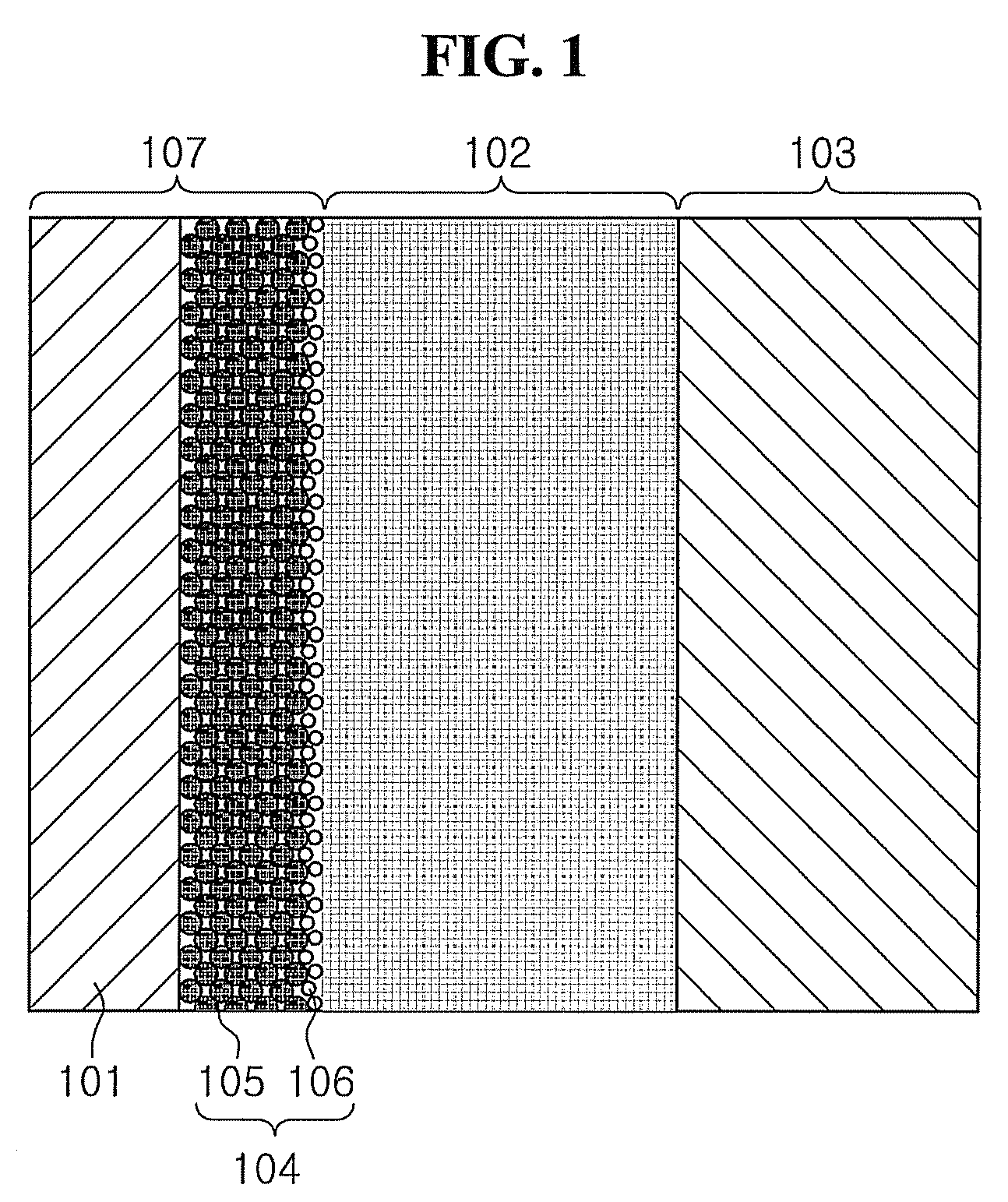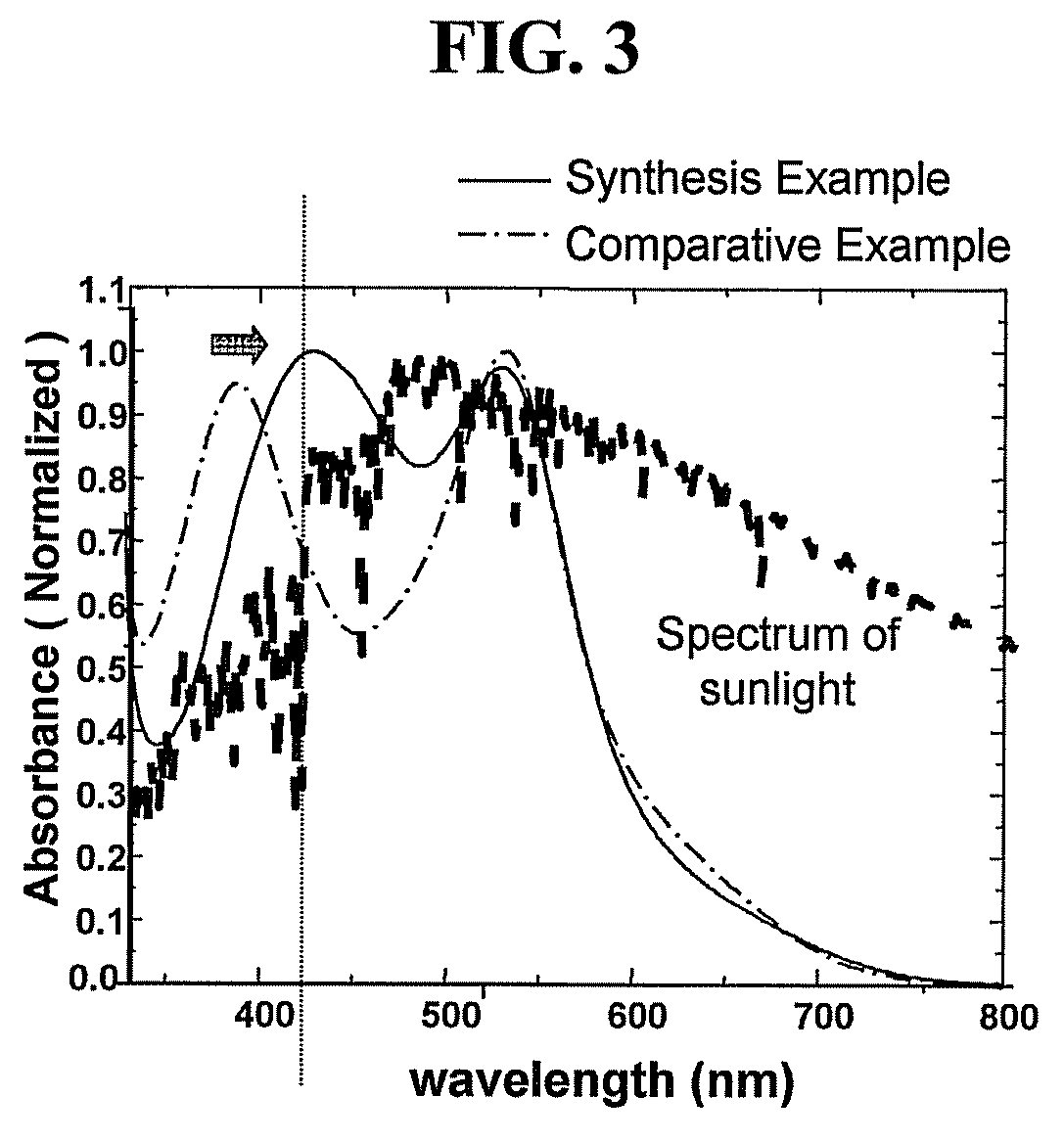Dye for photoelectronic device, photoanode comprising the dye and photoelectronic device employing the photoanode
a technology of photoelectronic devices and dyes, which is applied in the direction of discharge tubes/lamp details, natural mineral layered products, synthetic resin layered products, etc., can solve the problems of unmet needs in the art, the improvement of cell efficiency, and the limitation of the practical application of cells, so as to improve light absorption efficiency and good sensitivity to sunlight
- Summary
- Abstract
- Description
- Claims
- Application Information
AI Technical Summary
Benefits of technology
Problems solved by technology
Method used
Image
Examples
synthesis example 1
Synthesis of the Dye
[0050]
A solution of 4,7-Diphenyl-1,10-phenanthroline (266 mg, 0.8 mMol) and dichloro(p-cymene)ruthenium(II) dimmer (240 mg, 0.2 mMol) in 50 ml (milliliters) of dimethylformamide (‘DMF’) was refluxed under a nitrogen atmosphere at 100° C. for 4 hours. After 4,4′-dicarboxy-2,2′-bipyridine (216 mg, 0.8 mmol) was added to the solution, the mixture was refluxed at 160° C. for 4 hours. Ammonium thiocyanate (NH4NCS) (608 mg, 8 mmol) was added to the hot mixture and refluxed at 140° C. for 4 hours. Subsequently, the resulting mixture was allowed to cool to room temperature and the solvent was removed by distillation under reduced pressure to obtain a purple solid precipitate. The precipitate was added to 300 ml of water and dissolved by sonication for 5 minutes. The pH of the solution was adjusted to pH 4 by the addition of a 0.2 M nitric acid (HNO3) solution. The acidic solution was subsequently allowed to stand in a freezer for one day to obtain a precipitate. The prec...
example 1
Production of a Photoanode and Fabrication of a Photoelectronic Device
[0053]After fluorine-doped tin oxide (FTO) was applied to a glass substrate using a sputter coater, a paste of TiO2 particles (particle diameter: 13 nm) was coated thereon by screen printing, and then baked at 450° C. for 30 minutes to form a porous TiO2 film having a thickness of about 15 μm (micrometers). Subsequently, the glass substrate, on which the TiO2 film was formed, was dipped in a 0.3 mM solution of the dye (Synthesis Example 1), prepared in a mixture of butanol and acetonitrile (1:1 (v / v)), for 24 hours and then dried to allow the dye to adsorb on the surface of the TiO2 layer, thereby completing production of a photoanode.
[0054]Next, platinum was deposited on a glass substrate coated with indium tin oxide (ITO) using a sputter coater to form a platinum film, and thereafter, a fine hole for injection of an electrolyte was formed thereon using a drill (diameter: 0.75 mm) to produce a cathode.
[0055]The p...
PUM
| Property | Measurement | Unit |
|---|---|---|
| pH | aaaaa | aaaaa |
| height | aaaaa | aaaaa |
| thickness | aaaaa | aaaaa |
Abstract
Description
Claims
Application Information
 Login to View More
Login to View More - Generate Ideas
- Intellectual Property
- Life Sciences
- Materials
- Tech Scout
- Unparalleled Data Quality
- Higher Quality Content
- 60% Fewer Hallucinations
Browse by: Latest US Patents, China's latest patents, Technical Efficacy Thesaurus, Application Domain, Technology Topic, Popular Technical Reports.
© 2025 PatSnap. All rights reserved.Legal|Privacy policy|Modern Slavery Act Transparency Statement|Sitemap|About US| Contact US: help@patsnap.com



